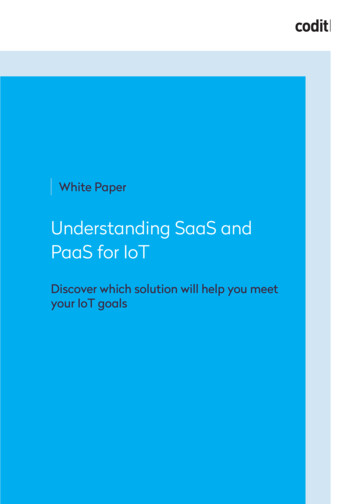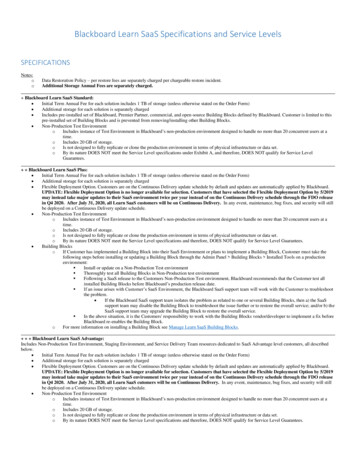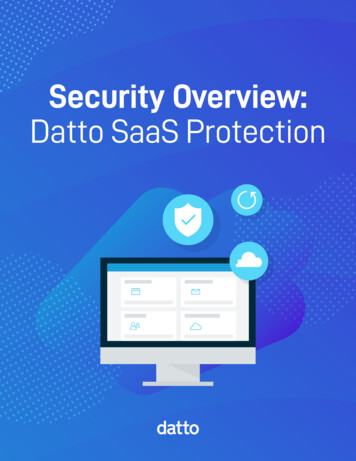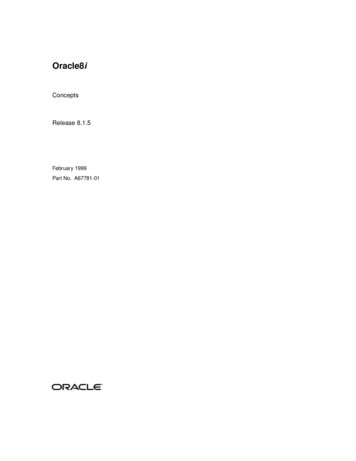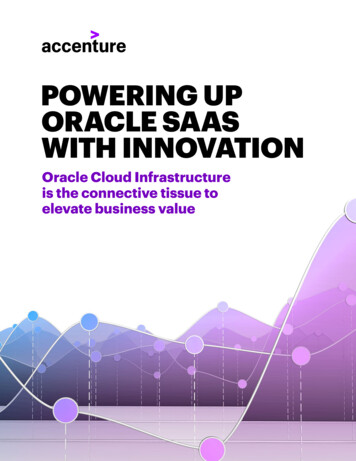
Transcription
POWERING UPORACLE SAASWITH INNOVATIONOracle Cloud Infrastructureis the connective tissue toelevate business value
With markets in a state of permanentdisruption and traditional industrylines blurring, bold business leadersare seeking to create futureopportunities while dominatingthe market today.They view innovation as a way of being andthe only path to success. Innovation shapeshow businesses attract and engage withcustomers, employees and suppliers. Savvybusiness leaders consider that customershave more options than ever, the workforcehas greater mobility than at any time in historyand supplier interactions come with highexpectations. In this ever-changing businessenvironment, market leading organizationsembrace change by shaping their businessto maintain a competitive edge. They striveto improve effectiveness with customers,spur engagement with employees and gainefficiencies with vendors. To power theseinitiatives, business and IT functions mustcollaborate through the adoption of newtechnology. Software as a Service (SaaS)provides ready-made solutions to acceleratemany of these programs.The upside of moving to a SaaS model is clear:it is a cloud framework from which innovationcan be continuously delivered. Leveraging acommon cloud platform, these applicationsstandardize processes, automate functionsand provide a cost-effective way to modernizecore applications. SaaS applications embodymodern leading practices, allowing forpersonalization and configuration to fit clientrequirements. However, the one-size-fits-allapproach means that companies mayencounter misalignment between thestandard functionality and their businessprocesses. As a result, companiescompromise on functionality in some areas,2create workarounds to get what they needin other areas, and, potentially, find somebusiness requirements that requireextensions to SaaS.Oracle Cloud Infrastructure (OCI) productsare the connective tissue that links togetherOracle SaaS and the complex businessrequirements to deliver unique functionalityon the way to a high performing solution.OCI simplifies the connection of Oracle SaaSwith other enterprise systems. It enablesthe creation of targeted and customizedapplications that extend Oracle SaaS tomeet a broader range of business needs.OCI facilitates extracting value from dataallowing leaders to drive thoughtful andconsiderate business decisions. The use ofa common Oracle Cloud platform illustrateshow combining applications with platformtechnologies helps companies increaseefficiency and competitiveness. WhereOracle SaaS provides the core capability,OCI supplies the glue to pull those solutionstogether and amplify the business value.As a global leader in Oracle SaaS programs,Accenture leads with OCI as a key componentof the client’s solution. For eachimplementation, Accenture partners withclients to define their Oracle InnovationStrategy as part of Accenture’s Oracle Clouddelivery methodology. All of this is executedthrough Accenture’s myConcerto for OracleCloud, an insight-driven, digitally integratedplatform that orchestrates the power ofnew Oracle solutions and technologies,and Accenture’s industry and functionalexpertise—methods, tools, solutions,capabilities—to create exponentialbusiness outcomes.POWERING UP ORACLE SAAS WITH INNOVATION
REALIZING THEBOUNDARIES OF SAASAs organizations strive for success intheir Oracle SaaS journey, Accenturehas observed 4 key principles whereOracle SaaS consistently challengesdynamic organizations.03 Extracting value from dataseparates the leaders fromthe laggards.Leveraging Oracle’s common cloud platformto move beyond these boundaries could bethe difference between an Oracle SaaStransformation realizing the business caseor failing to find the value.Oracle SaaS reports and dashboards provideoperational data access to operate thebusiness. Driving the business ahead of thecompetition necessitates OCI for enhancedanalytics, AI and natural language processingto obtain insights and enable strategicdecision-making.0104 Competitive advantage comesUser experience is paramountto adoption.Oracle SaaS brings a much-improved interfaceover most legacy applications. That said, forcertain users, elevating the experience of theirspecific use cases with OCI with AI-poweredconversation or a simplified user interface cangreatly improve engagement.02Seamless integration unifies acomplex ecosystem.Oracle SaaS is rarely self-contained andmoving data externally is a necessity.Orchestrating that data movement efficientlyand securely involves robust integrationservices using OCI to minimize complexity.3from differentiated processes.Oracle SaaS creates standard processesthat should be leveraged where possible.Maintaining an organization’s secret sauceentails using OCI to extend the functionality.Accenture has found Oracle’s CloudInfrastructure products to be highly effectivein driving enhanced value for clients tocomplement their Oracle SaaS application.As OCI is tightly coupled with Oracle SaaS,it enables secure connectivity and soundperformance. It has native compatibility withOracle SaaS, leveraging common frameworksthat streamline implementation. Security,identity and access management functionsact as one across Oracle’s common cloudplatform. Interactions are seamless from theend user’s perspective. Altogether, the useof OCI with Oracle SaaS eliminates the needfor multiple third-party tools to address userexperience, integration, data & analytics andcreates the full functionality companies require.POWERING UP ORACLE SAAS WITH INNOVATION
UNLEASHING THE POWER OFORACLE CLOUD TECHNOLOGIESOracle Cloud Infrastructure’sunderlying platform services create anear limitless opportunity for clientsto add value to their Oracle SaaSjourney.The platform functionality supports customdevelopment, data management, data analysisand security among other capabilities.Companies can scale up or scale down thesolutions as business needs dictate, creatinga level of flexibility rarely seen in technology.Approximately 85% of Accenture’smore than 300 Oracle SaaS clientshave realized the value of OCI inelevating them above and beyond theboundaries of Oracle SaaS.User experiencedrives engagementThe breadth of Oracle SaaS functionalityprovides companies with feature richcapabilities, but it also means that the userinterface can be complex and daunting forusers. That’s especially true when firstmoving to Oracle SaaS or consideringinfrequent users. Users are typicallycomfortable with their legacy applications.4Adopting this new SaaS-based system isoverwhelming in many cases. The result:slower user adoption and impairedproductivity. Getting people up to speedrequires significant change-managementand training efforts. With OCI, companiescan engage users through voice, text anda more personalized manner.Accenture helped a government agencyaccelerate adoption and increase employeesatisfaction using Oracle Digital Assistant tocreate a conversational user interface (UI).A conversational UI combines voicetechnologies, artificial intelligence reasoning,and contextual awareness to “understand”the intentions behind the words. Executedthrough Accenture’s myConcierge asset,this new UI enabled employees to quicklyand easily get answers to policy andprocedure questions about the applicationsthey were using.This solution helped employees understandtheir applications and made them activeparticipants in the application roll-out. At thesame time, the agency was able to minimizethe need for dedicated internal staff to answeruser questions and direct employees to theproper training material. The digital assistantis available to employees via several channels,including text message, a chat interfacethrough the agency’s portal, or through theagency’s Microsoft Teams collaborationplatform. By making the digital assistantavailable through many channels, it hasbecome a seamless part of the employeeexperience.POWERING UP ORACLE SAAS WITH INNOVATION
Accenture helped a transportation companysimplify business processes using OracleVisual Builder Cloud Service (VBCS) to createa new mobile user interface. As the OracleSaaS UI evolves through quarterly releases,users may find it hard to keep up with thosechanges. The client’s users found the nativeUI was cumbersome to their business process.Using VBCS to prototype a new UI, the programwas able to create simplified functionality thatwould be stable as the underlying applicationevolved. Accelerated by Accenture’s RapidPrototyping capability, the working prototypewas created in just a few weeks with minimalinvestment. Early results show that the userscan more efficiently create transactions withless time spent in the application and moretime spent creating company value.Integrated ecosystemcreates simplicityCompanies need to move data out of OracleSaaS and into outside systems in a wide rangeof formats, and then return that data back tothe application, all while keeping the datasecure. The native integration capabilities ofOracle SaaS offers limited functionality. Datacan be extracted and loaded, but it cannoteasily be managed, transformed or processedfor use across systems. Many organizationsassume the embedded integration capabilitywill fit into their existing enterprise integrationframework. Some of those legacy tools andtechniques are hard to use with Oracle SaaS—if they can be used at all. With traditionalon-premise systems, companies have directaccess to databases, making integration withthe database a straightforward task. But withOracle SaaS, that access is intentionallyrestricted to reduce security risks.5The restricted access makes seamlessintegration difficult using legacy technology,and often requires companies to rely oncomplicated data handoffs. This results in afragmented approach that is cumbersome.It also complicates the task of keeping datafeeds current in the face of ever-evolvingOracle SaaS platforms.Accenture helped a multinationalconglomerate build a robust integrationarchitecture using Oracle Integration.Oracle Integration enabled the exchangeof data between Oracle SaaS and a varietyof other applications across cloud andon-premise systems. Fast-tracked throughAccenture’s Oracle Integration Factory, theOracle Integration based solution eliminatedmuch of the company’s integrationinfrastructure maintenance costs, andreduced the time needed to bring newbusiness units onto the Oracle SaaSplatform from days to hours.The time needed to deploy newintegrations was reduced by 50%,and at the same time, the companysaw uptime of 99.99% on the OracleIntegration stack while processingmore than 10 million journal entriesa day.POWERING UP ORACLE SAAS WITH INNOVATION
The client leveraged Oracle Integrations’sevent, API, and file-based data exchangesbetween enterprise systems and Oracle SaaSapplications. These exchanges are simplifiedby native Oracle SaaS integration architecturecomponents, some of which can only beaccessed by Oracle Integration. The clientleveraged Oracle Integration’s pre-builtintegrations to easily hook into Oracle SaaS.What’s more, those integrations are frequentlyupdated by Oracle to keep pace with theOracle SaaS updates. These parallel updatesallow companies to easily stay current andreduce the time required for regression testing.Data unlocks valueMany organizations fail to realize their businesscase due to an inability to harness the value intheir data. Those that succeed put intentionalfocus into measuring the right things pairedwith tools to properly analyze their data.Deriving value from data is a challenge whentrying to solely leverage Oracle SaaS to gaininsights. Oracle SaaS has tools that let usersextract and consume operational data, but theusers have restricted access to analyze andmassage data with limited advancedcapabilities like machine learning. As OracleSaaS is optimized to support transactionalbusiness processes, the reporting capabilitiescan struggle with performance and do notenable cross-module analysis. As a result,the capabilities are rarely robust enough toprovide executive level insights and an easyto use self-service platform.6Accenture helped a media company developa dashboard using Oracle Autonomous DataWarehouse (ADW) and Oracle AnalyticsCloud (OAC) giving executives a conciseview of corporate performance. Based uponAccenture’s Digital Boardroom, the teamused an iterative development cycle to delivera prototype to the client in a matter of weeks,putting Oracle SaaS data into a standard datamodel that is visualized on the dashboard.Blending data across Oracle SaaS modules,leveraging advanced analytics functions andfacilitating fast performance, ADW and OACprovided a low maintenance solution that farexceeded what was possible with OracleSaaS. The executive dashboard providesmeaningful insights tailored to their businessand supports strategic decision making.Accenture helped a public utility create asecure data platform using ADW to enableself-service reporting. The effort moved datafrom Oracle SaaS to a more easily accessibledata model in ADW. This approach allowedemployees to use their preferred visualizationtools to create custom queries and developtheir own reports and insights—rather thanrely on pre-built reports provided by theapplication. Since users were no longerextracting data from the application andmanipulating it on their desktops, theyavoided data-integrity risks and mitigatedsecurity issues. In addition to a more consistentexperience, users were provided with a dailyrefresh of data as opposed to the previousmonthly cycle. ADW enabled the organizationto maintain rigorous security and governanceover the data, while providing the users withthe self-service experience that they required.POWERING UP ORACLE SAAS WITH INNOVATION
Differentiate to competeFrom a business perspective, the value ofOracle SaaS is its ability to support simplifiedtransactions and standardized processesto increase efficiency. In some cases, thestandard application functionality may notbe a fit for all areas of the business. A uniquebusiness process, like customer experienceor talent management, may be the key todifferentiation in the market and key to acompany’s success. In the on-premises world,where companies had access to applicationsource code, the modification of systemswas straightforward, though labor-intensiveand difficult to support. With Oracle SaaS,modifications to the source code are notpossible, creating a need to support theunique processes in another way. Using OCI’sopen development framework, companies cancreate unified extensions of Oracle SaaS thatprovide the tailored functionality needed tosupport unique and differentiating processes.7Accenture helped a healthcare companycreate an Oracle solution that automatesevaluation of all supplier invoices as perHealthcare payer codes and rules, thenautomatically creates credit memos inOracle SaaS. The solution developed usingOracle Java Cloud Service (JCS) and OracleDatabase Cloud Service (DBCS) enrichedOracle SaaS functionality and enabled theclient to streamline their business process.The automation has helped the clientalleviate manual work, improveaccuracy and provide an annualsavings of 5 million.Accenture helped an agriculture companycreate a harvesting application thatautomates the entire food lifecycle fromgrow to harvest. Baked into the automationis integration to Oracle SaaS to generatethe payment to vendors (pickers, haulers,etc.) involved in various components ofthe process. As this functionality is veryindustry specific, the capability is notnatively available in Oracle SaaS. Thesolution developed using JCS and DBCSdelivered a comprehensive solution tothe client, enabling them to enhance thecompetitive advantage in their productlifecycle without changing their businessprocess.POWERING UP ORACLE SAAS WITH INNOVATION
STARTING YOURINNOVATION JOURNEYOracle Cloud Infrastructure enablesenterprises to be competitive anddigitally modern.Combining OCI with Oracle SaaS can addressevery business need, today, tomorrow and inthe future, all leveraging a common platform.Whether in parallel to an Oracle SaaSimplementation or in some cases in advanceof the program, making the move to OCI isrelatively straightforward and it can be donegradually. Companies can get started quicklywith focused projects, prove the value ofthose projects, and then apply that work toadditional business requirements.Accenture typically begins by usingdesign thinking sessions to develop a“hypothesis” solution that addresses acompany’s challenges. During thesesessions, Accenture leverages theinvestment in over 400 reusable OCIaccelerators, across the productportfolio, to help our clients quicklyrealize value.8The catalog of pre-built code, referencearchitectures, reference applications andenhanced documentation are proventhrough our successful deployments.This hypothesis is then tested and honedthrough an iterative development processthat includes prototyping and frequentfeedback, ultimately leading to a tailoredsolution that meets the company’s needs.That effort then provides a foundation forapplying OCI to other similar challengesover time.Overall, Oracle SaaS has proven to be veryeffective, and it will continue to be a critical,foundational business technology. But itcan’t be all things to all organizations. OCIprovides a cost-effective and proven wayfor companies to build on the Oracle SaaSplatform to improve the user experience,take better advantage of data, differentiatethe business, and get even more value outof their Oracle SaaS investments.POWERING UP ORACLE SAAS WITH INNOVATION
AuthorAbout AccentureBenjamin GettingerAccenture is a leading global professionalservices company, providing a broad rangeof services in strategy and consulting,interactive, technology and operations,with digital capabilities across all of theseservices. We combine unmatched experienceand specialized capabilities across more than40 industries – powered by the world’s largestnetwork of Advanced Technology and IntelligentOperations centers. With 505,000 peopleserving clients in more than 120 countries,Accenture brings continuous innovation to helpclients improve their performance and createlasting value across their enterprises.Visit us at www.accenture.com.North America Market Development Lead,AccentureBased in Denver, Colorado, Ben is Accenture’sNorth America Oracle Technology MarketDevelopment Lead, with responsibility forAccenture’s Go to Market and Partnershipstrategies for Oracle Cloud Infrastructuretechnologies. Ben brings his background inData & Analytics to educate clients on howOracle Cloud products can further transformtheir organizations and help them improvetheir competitive advantage.This document makes descriptive reference to trademarks thatmay be owned by others. The use of such trademarks herein is notan assertion of ownership of such trademarks by Accenture and isnot intended to represent or imply the existence of an associationbetween Accenture and the lawful owners of such trademarks.Copyright 2020 Accenture.All rights reserved.Accenture and its logo are trademarks of Accenture.Oracle is a registered trademark of Oracle and/or its affiliates.
Strategy as part of Accenture's Oracle Cloud delivery methodology. All of this is executed through Accenture's myConcerto for Oracle Cloud, an insight-driven, digitally integrated platform that orchestrates the power of new Oracle solutions and technologies, and Accenture's industry and functional expertise—methods, tools, solutions,





